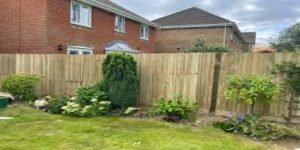Alpine Timber is renowned across Dundee as the go to company for quality garden fencing fife installation. It’s a huge undertaking that requires a lot of hard work. A fence, even at the low prices we provide, is an asset in your property. Although our fences are intended to endure, they eventually need to be replaced. In order to ensure the maximum life span of your fence, you must take things to yourself. The longevity of your fence is directly proportional to how well you take care of it. After the construction crew has left, you’ll be responsible for keeping your fence in good condition. Absolutely, you are not alone. To help you keep your fence in good condition, we have compiled this advice.
The upkeep required of your fence will vary with the materials used to construct it. To a greater or lesser extent, water is the enemy of any barrier. Your fence’s deterioration is probably due to water damage. You may extend the life of your garden fencing fife by doing simple things like keeping it clean. When all else fails, a good cleaning may do the trick. Nonetheless, the requirements for one material can’t be assumed to apply to another.
Upkeep of a Wooden Fence
Among the most traditional garden fencing fife materials is wood. However, being a natural product, wood presents unique issues in the area of upkeep. The main threat is water, as we’ve already established. Water expedites the rotting process that occurs in wood. Pests that consume wood, such termites, carpenter ants, and carpenter bees, are another source of worry. Lastly, wood may be damaged by the sun’s bleaching and drying effects, which can lead to splintering, warping, and final collapse. However, this issue may be mitigated with routine servicing.

Wood Preservatives
Applying a sealant like paint or stain right after the fence is built is the first step in keeping it in good condition. Waiting four to six weeks after installing pressure treated wood allows the wood to dry out fully before painting or staining. Taking this precaution will protect your timber from the destructive effects of moisture. It is recommended to wait 2-3 years between painting projects. It’s recommended to reapply stain every three to five years.
visit blog: Choosing The Right Garden Fence Panels Fife
Taking Stock of the Damage
Every month, take a stroll around your garden fencing fife to inspect it for signs of wear and tear. Check for splinters, holes, sagging posts, and broken or loose pickets. Keep a look out for loose nails, which might be present if the fence wasn’t erected properly. Pickets in a wood fence may be easily replaced if they are ever cracked or damaged. You can generally simply hammer the loose nails back into place if you locate any.
Scrubbing the Rails
Maintaining a tidy fence is also essential. Cleaning the dust and pollen from your garden fencing fife should just take a few minutes with some soapy water. Strong garden hose water or a mild power washer should remove more stubborn stains. Look out for any stains that could be green or black. Stains of a dark green or black colour are often the result of mould or algae and cannot be removed by washing. Mold and algae stains will return if the spores that cause them aren’t eliminated. Mold and algae are easy enough to eliminate with a simple solution of chlorine bleach and water (one cup bleach to one gallon water). White vinegar may be used in lieu of bleach for a greener alternative.
Upkeep of an Ornamental Fence
Most homeowners who opt for an ornamental fence do so because of how beautiful it is. Ornamental fences may provide both security and curb appeal to a property, but they do need regular upkeep to retain their structural integrity and aesthetic appeal. Metal fences have the same problem with water as wooden fences. Ornamental fences made of steel or aluminium are often coated with a sealant to preserve its colour, strengthen the material, and make it more resistant to corrosion. When inspecting an ornamental garden fencing fife for needed maintenance, it is most crucial to search for dings and scratches that might have compromised the coating. Corrosion of the underlying metal may occur if water is able to seep through any cracks in the covering.

Basic Tidying
It is best to spray an ornamental fence from the ground up and then back down with a garden hose to clean it. For the most effective cleaning with little leaking, spray in that sequence. Clean any lingering grime with a gentle cloth and some soapy water. When cleaning stubborn dirt and grime from a fence, it is best to use a soft power wash on the lowest heat to prevent harming the protective coating.
Localize the Problem and Fix It
Walk the entirety of the fence once a month and inspect it carefully for nicks, gouges, and other damage. Examine the walls for any signs of paint that is chipping, flaking, or peeling. If you notice the problem before the rust sets in, fixing it won’t be too much trouble. Remove the peeling paint first with a wire brush. After the area has been cleaned well, apply two coats of priming and two coats of rust-resistant paint. If rust has formed, the area must be stripped of paint and corrosion using a wire brush.
Upkeep of a PVC Fence
The vinyl fence requires the least amount of care and upkeep. A vinyl fence, however, does need occasional maintenance. Most of the problems that arise with other materials are not present with vinyl. It resists decay and corrosion. As it hasn’t been painted, it won’t chip or flake. There’s no risk of warping or moisture absorption with this material. The vinyl is built to last because to its sturdy composition. Nonetheless, grime and stains on the surface might make a vinyl fence seem worn and outdated.
Maintenance of a Vinyl Fence
Vinyl fences are very easy to maintain and clean. As a rule, nothing more complicated than a lawn hose is required. Spray from the bottom up, then back down again. Sponges dipped in soapy water may be used to eliminate any lingering stains. When cleaning a vinyl fence, the only time you’ll need anything extra is if the stains are still active. Typically, black, yellow, or greenish algae are responsible for living stains. You’ll need to eliminate the algae that’s causing the stain in order to win. Killing the algae and removing the discoloration requires a diluted mix of chlorine diluted bleach or, for a more natural method, white vinegar and water, as well as some elbow work. If you have a big enclosure and washing it by hand would take too long, consider renting a power washer and cleaning it using a concentrated cleaning solution designed for power washers.
Conclusion
The most common cause of fence failure is unsurprisingly water. The easiest method to keep your garden fencing fife in perfect condition and extend its life is to clean it regularly with a hose pipe, wash it by hand, or use a power washer. Every two to three years, or every five to six years, fences made of wood need to be refinished or restricted. Concerns about the protective coating’s integrity are paramount with an ornamental fence. Patching up any imperfections with primer and paint is a good plan of action. There is no need to do more than a quick surface cleaning to keep a vinyl fence as good as new.





